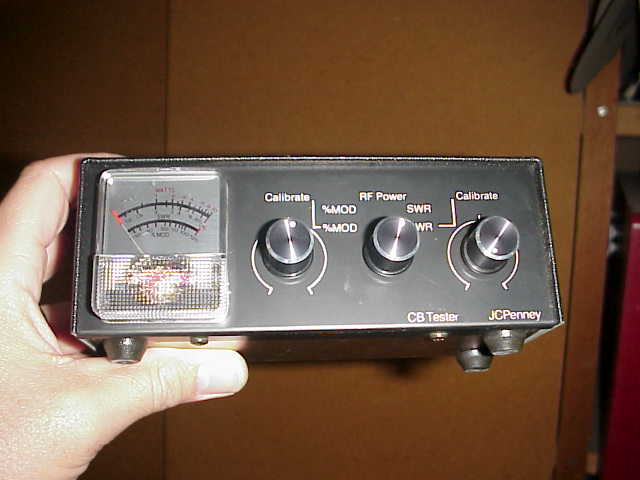Maintaining radio communications between vehicles, while on the trail, enhances the enjoyment of any trail ride. The ability to summon assistance in times of emergency can not be stressed enough. Various types of radios are available to help fulfill these communication needs. Although most of the methods and techniques covered here apply to all radio installations, I’ll use the CB radio as the focus of this article. It is the most popular radio in use today on the trail. (That does not mean it is the best type of radio to use for trail communications….it just means it is popular.) My experience in this area dates back to my first days of being a ham radio operator, more than 25 years ago. After high school, I enlisted in the US Navy and served 8 years as an electronics technician. The government spent well over a year on my education in electronics and radios….that is 40 hours per week, over 52 weeks of training. After my military tour, I taught electronics and communications theory for almost 6 years, employed by a college. I no longer work in the electronics field, but I still have my ham radio license and help a lot of my friends with their radio installs. I hope you will find some of this information helpful in assisting you with your radio installation project.
This article will not address the dozens of makes and models available on today’s market. New models emerge weekly while older ones disappear. This article will cover the basics of a good CB install and provide you with some tips and hints to help make your install a success.
For some anecdotal information on CB RF noise suppression, check this out.
DC Power
Your installation will be off to a good start when you connect your CB to a clean power source. What is clean power? Clean power simply means that the radio’s 12 volt power cable is NOT tapping into some other part of the Jeep’s wiring harness or a “borrowed” power point. By borrowed, I mean something like putting one of those “adapt a fuse” devices on the fuse panel so you can piggy-back your radio’s power cord on an existing fuse.
Dirty power can cause interference in your radio. Today’s vehicles come with a multitude of RF (radio frequency) noise generating devices. They were not designed to make RF noise, but do so as a byproduct of their normal operation. When operated in the near vicinity of the radio, or often times when sharing a common power circuit, these devices can reduce the ability of the receiver to pick up weak signals. They can also cause a hum or buzz to appear in your transmitted signal too. A few of the components that have been found to cause interference to radios include the engine computer, wiper delay module, electric fuel pump, dash panel gauges, and even the digital clock in the AM/FM radio.
If you tap into the wiring that directly supplies these components, you increase chance of getting RF noise on the power leads going to your radio.
By connecting your radio power leads directly to the vehicle battery, or as close as possible to the battery terminals, you reduce the chance of getting interference in your radio. Many off-roaders mount an aux power distribution block (i.e.., an extra fuse panel assembly) close to the battery and run their radio equipment from it. They usually hook their extra light systems into this block also. The lighting system is not a common source of RF noise and therefore can share the power connection without creating problems.
One thing to remember is that not all radios are as susceptible to RF interference as are others. Some vehicles do not generate as much RF noise as others. The mixing and matching of radios and vehicles can make it difficult to determine the source of the noise and likewise, a good fix to eliminate the problem.
Coax Cable
Good quality coaxial cable gets you one step closer to having a good reliable radio system. Stick with the name brands and you won’t regret it. Belden has made good quality cable for many years and continues to do so. Radio Shack’s coax cable has gotten better over the past few years. Their early offerings were pretty bad.
When routing the cable in your vehicle, try not to run it next to other vehicular wiring. By doing so, you run the possibility of picking up RF interference in your coax, and more importantly, you run the risk of causing RF interference with the many electronic systems in your vehicle. I’ve seen radio installations where transmitting on the radio results in a change in the vehicle’s cruise control setting. That is not a good thing to have happen. Many manufacturers, including Chrysler, publish recommendations on how to install two-way radio systems in their vehicles. I would recommend contacting your dealer or customer service office for more information on this topic. It is also possible to permanently damage vehicle electronics with RF energy from a radio transmitter. This is another good reason to stay legal and NOT run those illegal CB radio amplifiers. Your warrantee will be null and void when the component damage results from your radio transmissions.
Top quality cable will help ensure that RF energy does not leak into sensitive electronic components on your vehicle. Once your transmitted signal gets to the antenna, it will hopefully not cause any problems. If it does, you may have to decrease your power output to stop the interference.
When routing the coax, be careful not to crush or deform the cable. If the cable is squeezed or pinched going under the gasket on the trunk or tailgate, the impedance of the cable will change and it will make for a mismatched system. This mismatch cuts down on the efficiency of your antenna system and gives reduced performance. Considering how inexpensive coaxial cable is, spend a couple of bucks and replace it.
For a short how-to on installing a CB coax connector, check this out.
Antenna
The antenna used for mobile operations probably has the biggest influence on how well your signal gets out to others and how well you can hear your friends on the trail. There is more voodoo half-truths and plain bogus information about antennas floating around than any other part of your radio system. Part of the reason for this is that few people understand why and how an antenna works. Granted, you don’t need to know anything about antenna theory to use a CB radio properly. However, the less you know, the easier it is for a dishonest company to sell you a worthless antenna and and specially cut to length cables for way to much money. To make it worse, these company’s put up FAQs on their websites and fill them with a little bit of truth and the remainder with urban legend and old wives tales.
The shortest antenna that can electrically radiate RF energy is 1/2 wavelength long, or about 18′ in length for a CB radio. The 1/2 wavelength antenna can be constructed by using a 1/4 wavelength vertical element and a 1/4 wavelength ground plane. The result is a vertical (or whip) antenna that stands about 9′ tall (or 108″) and requires an RF ground plane underneath it.
For CB users, the most popular type of antenna is the 1/4 wave vertical. A quarter wave vertical is a ground dependent antenna. It uses the vehicle’s metal body as half of the antenna. This works out well for mobile operation because of the ease in which the upright radiating portion of the antenna can be mounted. Most of these antennas are not physically a 1/4 wavelength long. The old 108″ steel whip antennas that were so popular back in the ’70s CB craze were just that, a 1/4 wavelength long. A common CB antenna today measures about 4′ tall. One type uses a fiberglass rod and winds the wire around the rod, with the bulk of the wire being closely spaced at the top of the antenna. This is called a top loaded whip. Another antenna uses a 4′ long steel whip which protrudes from a large base, about the size of a small coffee cup. In this base is a coil of wire which makes up for the rest of the wire that is not sticking up into the air. This is called a base loaded antenna. Although there are other designs (most of which are totally bogus in what they promise for improved performance), the top and base loaded types are the most commonly used styles by people that know something about antennas.
Because your vehicle acts as half of your antenna, it is important to get a very good electrical (and RF) connection between the antenna mount and the car body. Many CB antennas have a 3/8″ x 24 studded base that screws into the antenna mount. The mount is usually located towards the rear of the vehicle. It is important to make sure that the bolts securing the mount to the vehicle body are making a good, clean contact. It is possible for the mount and vehicle body to be partially insulated from each other because of paint, rust, or powder coating. Usually, the mounting bolts (or screws) make a good enough connection by touching bare metal on both the mount and the body. High SWR problems are usually the result of a poor connection at the mounting point. Many folks refer to this as “having a bad ground at the antenna”. This is technically very wrong because the antenna is NOT grounded. The mount for the antenna is grounded. There is a big difference between the two and applying a ground to the antenna will cause infinite SWR and the possibility of a burned out RF power amplifier transistor in your radio.
Antenna Preference
I get asked time and time again which antenna I recommend. Up until recently, I didn’t have a particular favorite. I had found most name brand antennas to be pretty much the same as far as results are concerned.
I ran a 36″ long K-40 antenna for better than 5 years with very good results. It is extremely flexible and can be bent into a “U” shape without causing any damage to the antenna. For me, that is important as our trails can get rather overgrown with brush and desert plants. Snapping off your antenna in the middle of a trail run is a big bummer for sure. This antenna routinely ran a SWR of about 1.5:1 using a variety of mounts and several different mounting locations on my TJ. I would recommend it to anyone.
I had an old Radio Shack 4′ long antenna sitting in the garage that I kept as a spare. As it so happened, I was getting ready to run a trail with a friend of mine (BradW) and he had recently broken his antenna and asked if I had a spare. I brought it to the trail head and he installed it for the run. Wouldn’t you know it….part way through the trail, it broke right off at the threaded base. I told BradW not to worry as it was my old spare and its loss was not an issue for me.
BradW being BradW, he shows up a week or two later at my place with a new antenna. It was a 4′ long Wilson Silver Load (Flex-4, 5/8 wave). He had bought one for himself and one for me. BradW said that if I didn’t keep it, then neither of us would have a spare when we needed it. He wouldn’t take no for an answer and so I put it in the garage so a spare antenna would be available if needed.
A month later, I was remounting my radios in the TJ and so decided to give this new Wilson a try. I removed the K-40 and installed the Wilson on the quick disconnect mount I use for my antenna. A check and just a bit of adjustment at the antenna’s tuning tip yielded an SWR that was less than 1.1:1. I couldn’t believe how nicely the antenna adjusted and how low the SWR came in. I am impressed. I have mine optimized for the low end of the band (channel 4 in my case). At channel 40, it is about 1.3:1. Very good indeed.
The Wilson is also very flexible. It too can be easily bent in a “U” without any damage. BradW said his held up on the trail for many years before it required replacement. At just $25, that is pretty good considering the number of trail miles BradW racks up each year (ie., LOTS of them).
So…..if antenna height is your limiting factor, then try the K-40 antenna. If you can handle a 4′ antenna, then give the Wilson a spin. I feel confident that you will be very satisfied with either one. But like they say, length does matter…..so go for the longer one if you can.
SWR
SWR stands for Standing Wave Ratio. There is but one standing wave ratio that can be measured on the antenna coax cable, so please don’t say something like “My SWRs are pretty high.” By using the plural of SWR, you are only showing how stupid you really are….period, end of discussion.
There, with that out of the way, lets briefly discuss just what SWR indicates. Basically, the SWR measured in an antenna system indicates how well the antenna is matched, or adjusted in the case of most CB antennas. When all is well, the output impedance of the radio (50 ohms) matches the coax cable’s characteristic impedance (50 ohms) which in turn matches the antenna, which is hopefully 50 ohms. If the antenna is a bit too electrically long or short for the frequency it is operating at, some of the power being sent to the antenna will be reflected back to the transmitter. The more the antenna is “off frequency”, the higher the amount of reflected power. If the reflected power gets too high, it can cause damage to the transmitter and it will also limit your range and the ability of your radio to communicate properly with others.
When everything in your antenna system (coaxial cable and antenna) are doing fine, the standing wave ratio is 1:1 (pronounced 1 to 1). I always try to get things properly adjusted so that the SWR is at or below 2:1. It is not too difficult to get 1.5:1 or something close to that. With an SWR of 2:1, you have about 10% of the power being reflected back from the antenna. In the professional mobile communications install world, this is considered acceptable. I do not recommend operating a radio where the SWR is 3:1 or higher. At this point, you are getting quite a bit more reflected power (sorry, I don’t remember the exact mount) and you will certainly notice how poorly the radio performs (can’t hear many others, they can’t hear you very far away, etc.).
Typical CB Antenna Installation and Adjustment
I chose to mount my CB antenna on my Canyon City spare tire carrier. It offers a nice location for the antenna mount to be located. After center punching the spot, a 1/2″ drill bit was used to make a suitable hole and a standard 3/8″x24 mount was installed. Click here for details on installing the mount. Click here for details on install an RF coax connector.
Because I park my TJ in the garage, I have a problem with most antennas clearing the roll-up garage door. I stopped by the local ham radio store and purchased a Hustler 3/8″x24 Quick Disconnect (part # QD-2) for my K-40 3′ antenna.
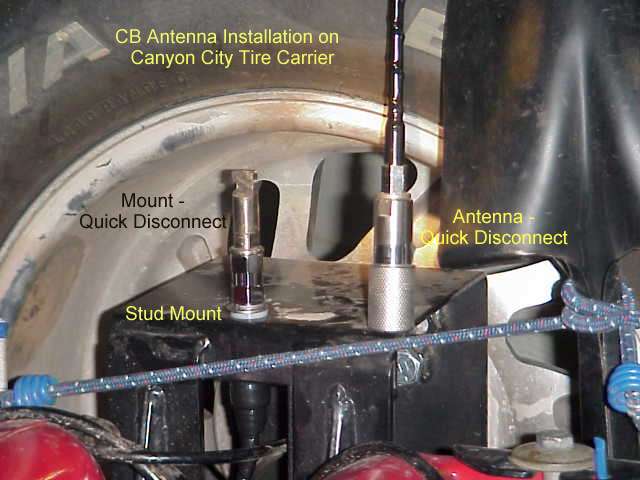
The antenna QD comes in two pieces. One part screws into the antenna mount that I installed on the tire carrier. It has the same size threads as the antenna (3/8″x24) so no adapters are required to attach it. The remaining part is attached to the bottom of the antenna. It is drilled and tapped to accept the antenna threads also. I used a lock washer on both of them and tightened them securely with a pair of wrenches.
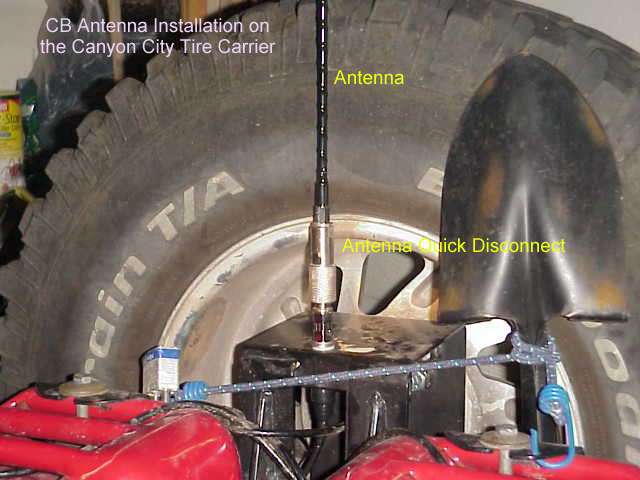
Once both of the QD sections are attached to the mount and the antenna, it can be connected. This type of QD uses a spring loaded quarter twist lock up which is easy to put on and take off. It holds the antenna securely in place while making it easy to remove in just a second. I have never had it come on the trail, regardless of how many branches it seems to get tangled in.
Once your antenna is mounted, run your coax via what ever path works for your setup. I used RG-8X coax. It is a lower loss replacement for the old and popular RG-58 coax. It is a 50 ohm coax so direct replacement is no problem. Make sure that when you route the coax, you avoid any situations that would leave the coax vulnerable to be snagged on an object while off-roading. Also be sure to route the cable so that it can not be cut, crimped, or smashed.
After you have the coax properly routed from your antenna to your radio location, it is time to adjust the SWR.

Here is an old but reliable SWR/Power meter that might very well be older than you. I got it in the early 70s from a CBer who worked with me when I was first in the Navy. It measure not only SWR but also power output and % of modulation. I might add that I have compared this unit to my more expensive power meters I have for my ham radio equipment, and it is quite accurate.
In order to accurately adjust your antenna, you will need to beg, borrow, or steal (OK, skip the steal part) one of these. You will be doing yourself a big UN-favor if you don’t adjust your antenna for minimum SWR. Thinking it will be adjusted properly when you take it out of the shrink wrap is about as probable as you hitting the jackpot by playing just one quarter in the slot machine.

On the back or sides of the SWR meter, you will find two coax connectors. One of these will be labeled “Antenna”. Connect the coax you just ran to this connector. Connect another coax cable, about 3′ long, to the remaining connector. The other end of this cable will be connected to the coax connector on your radio.

Note that the following steps are generic in nature, but will be typical of those you will perform when you adjust your antenna for minimum SWR.
After you have the cables connected, apply power to the radio. Set the radio to channel 20.
Put the SWR selector switch in the SWR Calibrate position.
Key the radio and adjust the SWR meter for a full scale reading. This is done by adjusting the Calibrate control until the meter reads full scale
Unkey the radio.
Put the SWR selector switch in the SWR position.
Key the radio again and read the SWR value from the meter. Note this on a piece of paper for future reference.
Adjust your antenna slightly, making it a bit longer and shorter (see the directions that came with your antenna). Check your SWR after each adjustment.
Your goal is to get the SWR as close as possible to a reading of 1:1 on channel 20.
When you have everything adjusted properly, the SWR measured on channels 1 and 40 will be somewhat higher, but should be less than 3:1. Most of the time, they will usually be around 2:1 or less.
If you favor one channel more than the others, you can also adjust your antenna for the lowest SWR reading on that channel. Here in Arizona, we use channel 4 all of the time for trail runs, so I have adjusted my antenna to favor the lower channels.
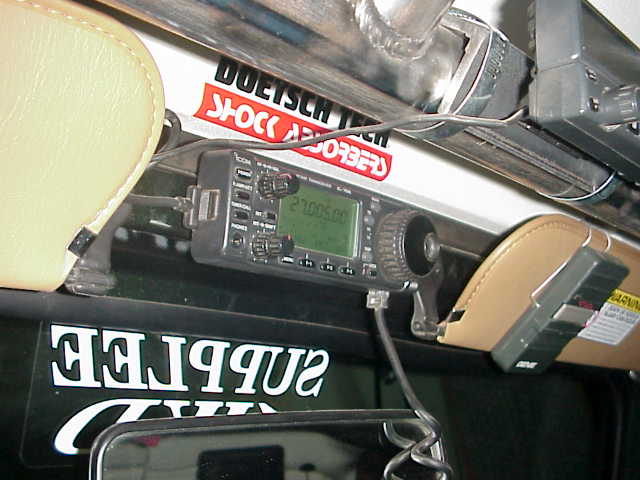
I thought I would include a picture of my HAM radios mounted on my windshield frame and the roll bar. Actually, they are just the control panels for the radios. The rest of both radios are mounted in the back of the TJ. This makes for a nice installation. Easy to use and never in the way. I wish they did the same for the CB radios. Unfortunately, it jacks up the price and I assume the CB manufacturers do not wish to do that.
Typical CB Antenna Mount
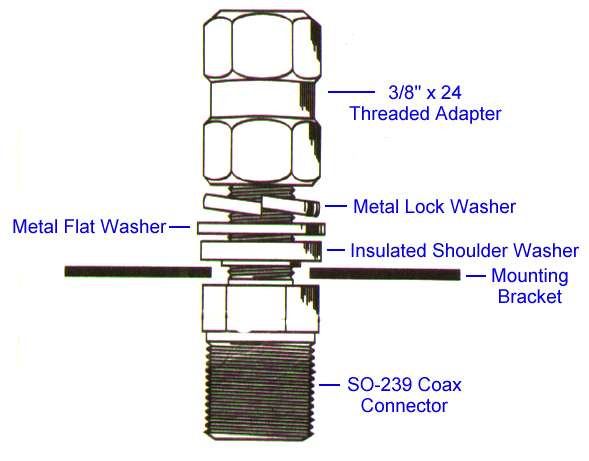
Figure 1
Figure 1 shows the exploded view of a typical CB antenna mount. The threaded end of the antenna is screwed into the adapter once the mount has been fastened securely to the mounting bracket, bumper, tire carrier, or whatever you are using as your antenna mount support. The antenna coax coming from the radio is attached to the bottom of the mount using the SO-239 connector.
It is very important to note that proper assembly of the mount is necessary in order to prevent the antenna from shorting to the mounting bracket. The most common error I see this mount is assembled is that the insulated shoulder washer is placed on the bottom side of the mounting bracket. When this is done, the connector body remains insulated from the bracket while the threaded adapter is shorting to the bracket. The last time I witnessed this, the CB radio would create a squeal in the transmitted signal. It was so strong that it was virtually impossible to hear the person talking. I have seen this happen a couple of times and it is a common error. As you see, when the insulated washer is directly on top of the bracket, as shown in Figure 1, it prevents any of the other metal parts from touching the mounting bracket and shorting out the antenna.
The SO-239 connector must make good electrical contact with the mounting bracket. To ensure a good install, sand away any paint or power coat that is directly around the hole so the connector will make a good electrical connection.
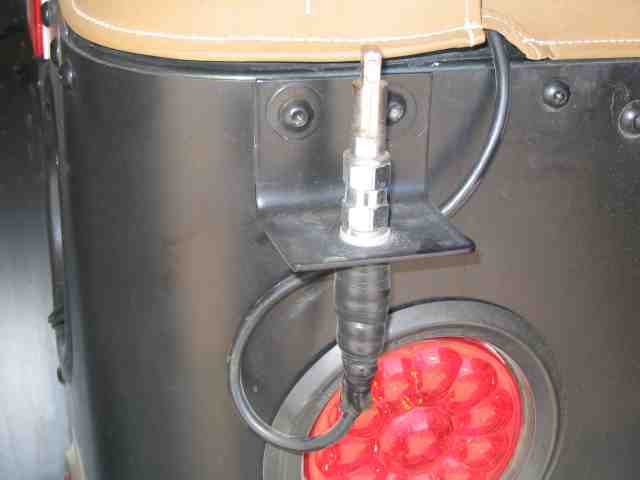
Shown above is a homemade antenna mounting bracket made out of a scrap of metal, about 3/16″ thick. I used two of the existing mounting bolts on my corner guards to secure the bracket in place. Round off the edges so no one cuts themselves on the bracket and you are good to go.
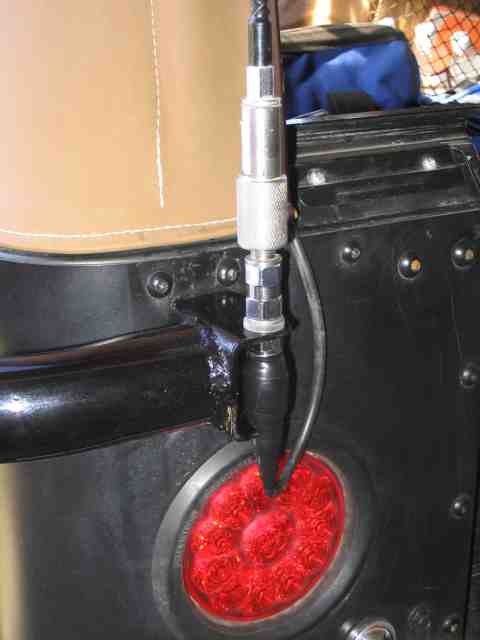
As of April, 2005, this is the current mount for my CB antenna. I did a slight modification to the rear mounting point of my driver’s side TBT side slider. It works just fine. Same location as the previous mount but now just making use of what was recently added.
CB Radio RF Noise Suppression
The following dialogue occurred with John, a JU member that I was exchanging on-line posts with while he was attempting to reduce the RF noise in his TJ when he was installing his CB radio. With his permission, I am including it here since I believe it is both valuable info and it gives others a glimpse at just what can be involved in trying to clean up a noisy RF environment in a vehicle. Considering that entire books have been dedicated to the subject, this is just a short review of the things that were done. Please note that some of this is as much magic as it is science….by that, I mean that what may work great for me does absolutely nothing for you and your Jeep’s CB radio…..or worse yet, you do it and it makes things worse. There are so many variables in the equation that you must understand that any one or a combination of these tricks (or others not listed here) may be just the cure for your noisy radio.
——————————————–
John,
There are three main sources of noise on most vehicles that enter via the antenna.
#1. Fuel system – mainly the electric fuel pump and the injectors (the pump is easily detected as it causes the noise when you turn the ignition key to ON (not Start) and then if it is like most pumps, it will pressurize the fuel lines and the cut off).
I have seen people use bypass capacitors on the power leads for the pump, near the point where the pump wires enter the gas tank. I have heard of some vehicle companies providing RFI (Radio Frequency Interference) filters to car owners who have severe problems.
#2. Ignition system – the spark plug wires are like little antennas with a spark gap transmitter hooked to them.
I have read of people taking the braid off of coaxial cable and making sleeves for the spark plug cables, etc. MUCH work and no guaranteed results. I have heard that some HAMS have had good luck with some very pricey ignition cables….$100+ for a set of wires but they have suppression built into them and the owners claim they worked well. Sorry, I don’t know the name but the search engines on the web should help here.
#3. Alternator – usually detected in the radio as a whistle or whine and follows the engine speed. Commonly enters the radio via the power leads but can enter via the antenna too. This does not appear to be your source of noise.
Concerning #2 above….I have had good luck reducing the ignition noise in my TJ by grounding the exhaust system. I put a ground strap (the shield from large size coax cable….but any good copper braid would work) about 10″ back from the end of the tail pipe. I used a stainless steel radiator hose clamp to attach it to the exhaust pipe after thoroughly wire brushing that area of the exhaust pipe nice and shiny. The other end of the copper braid was attached to the frame…..wire brush it clean too and screw it down tight. I soldered a terminal lug on this end of the copper braid.
Well, that is about all I can pass on. There are books available at ham radio stores that deal specifically with vehicle RFI reduction, if you get serious about it. They will no doubt have more ideas to try than I can remember here.
Good luck! 
Edit: John, do you have a single coil system or one of the new multi-coil ignition systems?
——————————————–
2002 TJ sport.
I have a multiple coil direct fire system.
I have tried a noise supressor / capacitor on the alternator. No difference. Not a whole lot I can do about the injectors or the coils noise.
I will try to check out the fuel pump noise. Maybe I can get that sort of under control. I will also give the exhaust a shot.
The noise is *definately* proportional to engine RPM.
Edit:
I think the fuel pump is the culprit. I crawled under there while the engine is running and can hear a high-pitched whine. I can’t imagine that is friendly to the CB radio.
Now, how to get rid of fuel pump noise.
There are a bunch of wires, which ones should I get put the capacitor on? I still don’t have a FSM, that was on the list for this month.
Best regards
John
——————————————–
Stu, thanks for the links. I checked them out and followed some of the directions.
I made myself a little sniffer out of my other piece of coax. I tried tests with both my battery and another car battery in a different car all together.
If I ground both ends of the shield while hooked up to another car battery, the radio is silent until I get the sniffer end close to the exhaust tip, top of the hood, or the rear door of the Jeep. I will get some ground straps to see about that. It cannot hurt.
When hooked up to my battery with the engine running, I get tons of noise no matter whether or not the coax is hooked up. The noise is louder with the coax hooked up, but the noise is still very loud without it being hooked up.
I have a cheapo noise filter, but I really do not think it is up to the task of power cleaning duties for a CB. I probably need to get a better one from a HAM shop or some place like that. Recommendations of a good quality line filter?
That under-hood area is *extremely* noisy. I may have to see about adding a little capacitor on top of the Jeep battery as an experiment.
I also tried out some aluminum foil on top of the direct-fire ignition and another piece over the injectors. It seemed to help even out some of the noise — but not eliminate it.
Anyway, by itself, I am just getting too much noise in through the battery connections/ underhood area for the Cb to be much use except close on the trails. Once I have that sorted out, I will try quieting down other things too.
If you have any ideas, please post them for me. I have tried every idea I have been given, and I am closer now than I was. Now, I know which direction I need to go first.
Thanks for all the help.
Best regards
John
——————————————–
Ok, got the filters in, no more dirty power. Now, I have a big honkin radio shack beast with the little cheapo piggy-backing in series. Mmmmm quiet power — but only with a good routing of the power wire and a short ground.
Power wire:
The faster you can get it out of the engine compartment, the better, but hooking up to a power lead out of the fuse-box is bad like in the engine compartment. The direct fire ignition and fuel injectors makes gigantic noise. It is happiest with a length of RG-8 cable running the power. The quietest reasonable routing I could come up with was down behind the battery, along the floorboard, and back up through one of the drain holes. The shield is best left un-grounded — It seems to cut down on the noise. It is much better than regular wire — but only when the shield is not connected to anything. Weird.
Ground strap + muffler clamp on the exhaust pipe tip end seems to make it happy. No noise in the sniffer once that is hooked up. Good call Stu.
Fuel pump noise — terrible with rear door open. Rear door shut seems to cut most of that noise — though I still get a little hi-pitched whine. I have a 470pf capacitor to put on the fuel pump leads. I am going to run out the gas tank and then drop the tank and put in the cap on the pump. It can’t hurt.
Ground location — Cleaned off all the engine, body, and head ground locations. Brushed them off real good and hooked the wires and straps back up. That did seem to help some too. CB is happiest with a close ground to the front roll bar close to the CB mounting. It is *very* unhappy with a direct battery or underhood ground — even when the lead is exiting the engine compartment quickly.
One point of weirdness that I found. When I have the sniffer coax hooked up…… For some odd reason, it is happy when the center lead of a length of shielded TV (rg-6u) coax is hooked up to the body ground point. Only 1 end though, and without the shield grounded. A jumper cable worked too — hooked up on only 1 end to the CB ground point. Neither regular wire, nor RG-8A worked so well, though. I will try a cheapo spark plug wire tomorrow. That makes me think I have some weird ground plane issues — and not real sure what to do about that. Food for thought for you HAMs out there. Maybe it will ring a bell with someone.
Overall, this is a real learning experience, but knowing what I know now, I would have bought a *much* more expensive CB with good noise supression. I have probably paid close to the cost of the CB again over in misc stuff to get it working right.
Thanks for the help. If anyone has some ideas, or any of this rings a bell, give me a suggestion.
Best regards
John
——————————————–
Hey all
Finished up grounding the frame directly to the battery today. Yesterday night, I moved the ground strap that connects the head, hood, and body to connect directly to the battery/body connection.
That quieted down the engine noise *substantially*
Now, the major noise source is a high-pitched whine from the electric fuel pump. To give you an idea, I could not run the gain up enough to pick up the fuel pump before — I was getting so much engine noise radiating through *everything*else that it drowned out everything including the incoming signal.
I will try out the 470pf ceramic disc capacitor trick on the fuel pump leads to see if it helps some.
This is a totally different CB radio. Still cheap and I would not buy this model again, but I have made *considerable* progress from the beginning.
I will put money on the fact that the Cell phone head-set will work much better too.
Best regards
John
——————————————–
Hey all
Thanks for all the suggestions, links, and moral support.
Finally got the 0.1 micro-farad capacitor in the fuel pump power lead.
The final piece of the puzzle.
This thing is *much* better with the engine running. 

I can actually hear things with the gain all the way up and the squelch all the way down *other than noise*
I still have a *little* engine noise and fuel pump noise — but only with the gain all the way up and the squelch all the way down. but I am happy to say I am done. Now, I have to turn down the gain a little to get rid of the power line noise and stuff like that.
Best regards
John

